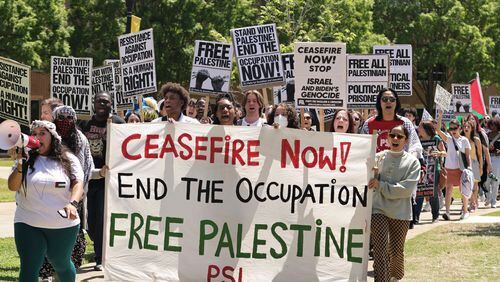Childhood cancer facts:
- 12,700 children will be diagnosed with cancer in the next 12 months.
- In Georgia, more than 430 children will be diagnosed with cancer this year.
- A newborn female has a one in 333 chance of developing cancer by age 20.
- Cancer is the No. 1 cause of death by disease in children.
- The average age of a child diagnosed with cancer is 6.
- One out of 5 children with childhood cancer die.
- Every school day, 46 young people (or two classrooms of children) are diagnosed with cancer.
- Three out of five children suffer from long-term side effects of cancer.
- Only 2 percent of federal funding for cancer research is focused on childhood cancers.
- There are more than 25 different types of childhood cancer, each requiring its own research.
Source: Cure Childhood Cancer
To make a donation to Press On to CURE Childhood Cancer, log onto www.pressonfund.org.
Last week, Erin and Stephen Chance of Druid Hills returned to the place where their son Patrick died from neuroblastoma, a solid tumor of the sympathetic nervous system.
It was one of the hardest things they’ve ever done.
But for years before Patrick’s death last January, the Chances, who are both lawyers, had resolved to be in this fight for the long haul. From the moment they learned of his diagnosis, they began raising money to fund new treatments for neuroblastoma and in 2007 joined forces with CURE Childhood Cancer Inc. to make their efforts official.
And so here they were, back at the Aflac Cancer Center of Children’s Healthcare of Atlanta at Egleston, to talk about Patrick and the center’s new MIBG (metaiodobenzylguanidine) radiation therapy room named in his honor.
Before the therapy room was built, metro Atlanta families like the Chances had to seek MIBG treatment far from home. The new radiation therapy room at Children's is one of only about eight in the nation, a scarcity caused by cost and a lack of clinical expertise.
“We’d experienced firsthand how hard it was to travel for treatment, to be separated from family, your emotional support and your hospital,” Erin Chance, 39, said. “So, we wanted to provide a place where families in the Southeast could come without traveling so far.”
MIBG treatment has a distinct advantage over traditional radiation.
“Many patients with cancer, when they receive radiation, lay on a table and a beam is focused on them. … A problem with that treatment is while it’s focused on the tumor itself, it hits other parts of the body. It works, but it has some collateral damage,” said Dr. Howard Katzenstein, director of the Innovative Therapy Program for cancer at Children’s Healthcare.
“This MIBG treatment allows the patient to be injected with the radioactive drug that targets the cancer cells directly. The radiation goes inside the tumor and the cells die. There’s a lot less surrounding damage,” Katzenstein said.
Talks to bring the treatment to the Aflac Cancer Center began six months ago when the CHOA Foundation requested a grant from the Chances.
“Stephen and I talked about it for about 30 seconds before we decided to fund the project,” Erin Chance said.
Because of their personal experience with the therapy, they also volunteered to help with the design. Instead of one room, they decided they needed two. One for the patients and one for the family.
When Patrick received MIBG treatment in Philadelphia, for instance, Erin Chance said he had to be isolated from them because he was literally radioactive. They were separated by lead shields, unable to safely touch or see him for days.
“If Patrick would fall asleep or was watching a movie, Stephen and I sat in the hallway to limit radiation exposure,” she said.
Stephen Chance, 44, said they decided to install televisions in each room along with three-way video and microphones, one for the nurses, and the others for the parent and child so that they can see each other on the monitors, talk to each other and actually play video games with one another.
“The parent is protected (from radiation) but has improved access to the child,” he said. “And the nurses can see the child on the monitor without exposure to radiation as well.”
The cost to build the connected rooms was more than $200,000.
Although the therapy room was built with neuroblastoma in mind, Katzenstein said it will also allow for similar treatment for thyroid cancer patients.
“If other drug treatments become available for other types of cancers, the room is built and we’re good to go,” he said.
Patrick Chance was 3 years old when he woke up one morning in 2006, unable to walk.
“From the moment he was diagnosed, it was obvious that there was a need for less toxic, more effective childhood cancer therapy,” Erin Chance said.
It was then that the couple began raising money to fund those new therapies and donating the proceeds to Children’s Healthcare of Atlanta.
In June 2007, they began collaborating with CURE Childhood Cancer, a nonprofit that funds research and provides support to patients and their families. The Chances formed Press On to CURE Childhood Cancer with another family to fund therapies for neuroblastoma and acute myeloid leukemia, two of the deadliest pediatric cancers in the country.
CURE provides them administrative support, a board of directors and a scientific advisory council.
“Their support enables us to do what we do best, which is fundraise,” Erin said.
Over the next five years, all the while caring for Patrick and his two sisters, they pressed on. Patrick died Jan. 9, 2012, his ninth birthday.
On Jan. 9, 2013, the Chances, Kristin Connor, executive director of CURE Childhood Cancer, and other dignitaries celebrated the grand opening of the new therapy room.
“In a lot of cultures, if you die on your birthday, it’s a sign you perfectly completed your mission on earth,” Erin Chance said. “For me, dedicating this room a year after he died was another completion of that circle. It was part of fulfilling what I believe was his mission on earth: touching people’s lives and changing the course of childhood cancer treatment.”
To date they have raised more than $1.5 million and have donated the money to leading childhood cancer hospitals across the country.
“We’re not done,” Stephen said. “We want to bring more resources to CHOA to help improve childhood cancer therapy. There are lots of January 9s yet to come.”
About the Author






